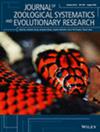A New Interactive Web-Based Polytomous Key for Species Identification of Pin Nematodes of the Genus Paratylenchus Micoletzky, 1922 (Nematoda: Paratylenchinae) with the Use of Ribosomal and Mitochondrial Genes
Abstract
Pin nematodes of the genus Paratylenchus comprise 140 species. This group of nematodes is characterized by a quite homogeneous morphology and cosmopolitan distribution and is prevalent in cultivated and natural soil ecosystems. The present study describes the first interactive and illustrated web-assisted polytomous identification key for the genus Paratylenchus. The updated Paratylenchus species polytomous key was based on a wide list of 24 diagnostic characters generated for the 140 species comprising this genus. Here we developed a web-assisted method to achieve an easy and accurate Paratylenchus species characterization that will greatly improve the identification of these plant-parasitic nematodes for many diagnostic laboratories and researchers. However, this identification needs to be completed with the use of molecular markers available for the species due to the existence of species complexes studied in former researches. This idea is pointed in the polytomous key in the specific species complexes up-to-know. In some cases, the presence in the soil as survival stage of few individuals in the fourth-stage juvenile (J4) required the use of molecular markers for species identification. We suggest the use of at least a fragment of mitochondrial COI gene for species identification or the combination of nuclear D2-D3 regions of the 28S rRNA and the COI to complement each marker. However, for some species complexes, the use of the D2-D3 regions alone has not enough resolution to separate the putative species inside the species complex. Web-based polytomous key was constructed using the free software Xper3, for computers and mobile devices (smartphones, tablets, and pocket PCS).


 求助内容:
求助内容: 应助结果提醒方式:
应助结果提醒方式:


